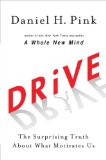I grew up in a time when church frequently included special gospel meetings that featured a guest preacher imploring nightly over the course of a week to get right and reap the rewards of heaven or certainly go to hell. We were encouraged to invite our friends and neighbors where every night the message and volume would escalate until a satisfactory number had responded to avoid the punishment of hell. Unfortunately, the fear motivated responses rarely resulted in life-long change, many left the church quickly never to return.
 As I read Daniel Pink’s book Drive: The Surprising Truth About What Motivates Us it struck me that we have built a church, family, and work culture based on an inferior motivational model. In a sense, our churches are stuck in a 20th century when such practices were the norm, but fall short with today’s generation. Because we were raised in this environment most of today’s leaders are just modeling what we know.
As I read Daniel Pink’s book Drive: The Surprising Truth About What Motivates Us it struck me that we have built a church, family, and work culture based on an inferior motivational model. In a sense, our churches are stuck in a 20th century when such practices were the norm, but fall short with today’s generation. Because we were raised in this environment most of today’s leaders are just modeling what we know.
Pink presents a compelling case for a deeper method of personal, peer, and subordinate motivation. He contends that human motivation has evolved from a basic needs model, to a “carrot and stick” model, and as he proposes, a more stable intrinsic motivation model. In modern vernacular he labels these models in the style of a progressive human operating system upgrade: Motivation 1.0, 2.0, and 3.0.
Motivation 1.0 (biological survival): The original (ancient) motivation was based on the drive to survive, pushing humans to seek food, water, shelter, protection, and procreation.
Motivation 2.0 (reward and punishment): As more sophisticated societies developed and human desire became more complex (and distant from God) human drive developed to seek reward and avoid punishment. Motivation 2.0 was used exclusively through the 20th century in the workplace but was also invoked during the “hell, fire, and brimstone” gospel meetings of my youth. Sin you go to hell, don’t sin you get to go to heaven. Pink identifies people motivated through external factors (1.0 and 2.0) as Type X (for extrinsic)
Motivation 3.0 (intrinsic): Intrinsic motivation is based on the inherent satisfaction received from autonomy, mastery, and purpose. Satisfaction is our reward. Those driven by internal factors are labeled “Type I” (for intrinsic) and are driven by three components:
- Autonomy – the urge to direct our own lives (faith)
- Mastery – the desire to get better at something that matters (Holiness)
- Purpose – The yearning to do what we do in the service of something larger than ourselves (God’s will)
Jesus preached motivation 3.0 in his “sermon on the mount” recorded in Matthew chapter 5 when he spoke of internalizing the Motivation 2.0 laws of Moses. He taught that instead of not murdering (Type X) to not even be angry (Type I) and instead of not committing adultery (Type X) don’t even look at someone else with lust in your heart (Type I). He went on to describe Type I attributes relating to oaths, divorce, enemies, prayer, retribution, worry, and discernment.
Perhaps the moment that best illustrates the coming and monumental change was when the Pharisees (the masters of Motivation 2.0) asked Jesus about the commands that were important. When he answered he established that unless we love God from within, there is no power in obeying the laws.
Hearing that Jesus had silenced the Sadducees, the Pharisees got together. One of them, an expert in the law, tested him with this question:
“Teacher, which is the greatest commandment in the Law?” Jesus replied: ‘Love the Lord your God with all your heart and with all your soul and with all your mind.’ This is the first and greatest commandment. And the second is like it: ‘Love your neighbor as yourself.’ All the Law and the Prophets hang on these two commandments.” Matthew 22: 34-40 (TNIV)
Jesus has called us to be Type I Christians, motivated by the autonomy of our faith (that is, a faith that is our own, not of our ancestors), mastery of God’s will in our lives, and the purpose of glorifying Him for eternity. Our task as Christian leaders should be to use the example of Christ to motivate and influence our family, church, and subordinates intrinsically.
“Motivation is a fire from within. If someone else tries to light that fire under you, chances are it will burn very briefly.” – Stephen R. Covey
